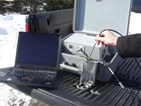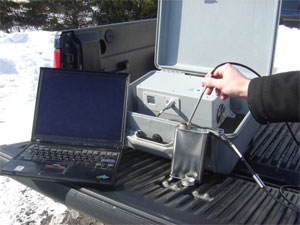Aspectrics Innovative EP-NIR Analyzer Provides Exact Measurements Of Biodiesel In B0- B100 Blends

 Pleasanton CA – Aspectrics, Inc., the innovator of patented Encoded Photometric Near Infrared (EP-NIR) spectroscopy technology, announced the availability of an application note demonstrating the ability of its MultiComponent 2750 EP-NIR analyzer to provide accurate measurements of biodiesel in B0 to B100 diesel blends. Derived from biological sources, biodiesel is gaining momentum as the energy source of the future being biodegradable, non-toxic and producing around 60% less net carbon dioxide emissions than petroleum-based diesel. The ‘B' factor is an international system used to state the amount of biodiesel in any fuel mix. Determining this amount is especially important to specify the purity level of a diesel blend.
Pleasanton CA – Aspectrics, Inc., the innovator of patented Encoded Photometric Near Infrared (EP-NIR) spectroscopy technology, announced the availability of an application note demonstrating the ability of its MultiComponent 2750 EP-NIR analyzer to provide accurate measurements of biodiesel in B0 to B100 diesel blends. Derived from biological sources, biodiesel is gaining momentum as the energy source of the future being biodegradable, non-toxic and producing around 60% less net carbon dioxide emissions than petroleum-based diesel. The ‘B' factor is an international system used to state the amount of biodiesel in any fuel mix. Determining this amount is especially important to specify the purity level of a diesel blend.
The Aspectrics MultiComponent 2750 EP-NIR analyzer used in this application was recently given an "honourable" mention at the Editor Awards during PITTCON 2007. This application demonstrated that when coupled to an external halogen NIR source and an extended range 2mm pathlength process transmission probe, the EP-NIR analyzer is capable of determining the precise percentage volume of biodiesel in various diesel blends within the B0-B100 range. The application note, entitled "MC2750 EP-NIR: Accurately Measuring Biodiesel % vol. in B0 – B100 Blends", is available to download free-of-charge via www.aspectrics.com
Samples of B0, B10, B20, B90, B95 and B100 were gathered and analyzed in several replicates. Focus was on the most common blending ranges, B0-B20 and B90-B100. The resulting spectra were randomly split into two groups, one used to develop a calibration model and the other one to validate the equations created for accuracy. Both Principal Components Regression (PCR) and Partial Least Squares (PLS) chemometrics methods were used to develop calibration equations.
During the analysis, the PLS model performed marginally better than the PCR model, resulting in a 99.9% confidence level of the finished blended product with an accuracy of ± 0.27 % volume. It was also demonstrated that the measurement of biodiesel percentage volume in the final blend can be easily carried out using chemical information characteristic of and specific to the biodiesel product only.
SOURCE: Aspectrics, Inc.
